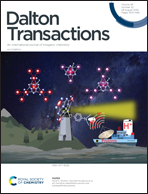Rational synthesis of an ultra-stable Zn(ii) coordination polymer based on a new tripodal pyrazole ligand for the highly sensitive and selective detection of Fe3+ and Cr2O72− in aqueous media†
Abstract
A mixed-ligand strategy has been used to construct stable luminescent coordination polymers (CPs). An ultra-stable Zn(II) coordination polymer, [Zn(H3tpb)(Hbtc)]n (1) was hydrothermally synthesized by employing a new tripodal pyrazole ligand H3tpb and a classical carboxylic ligand H3btc (H3tpb = 1,3,5-tris(pyrazolyl)benzene, H3btc = 1,3,5-benzenetricarboxylic acid). Complex 1 exhibits a 2D sql network. Importantly, 1 not only possesses excellent thermal stability but also shows superior chemical stability in terms of water resistance, acid/base aqueous solutions tolerance (pH = 2–12), and organic solvents resistance. This excellent structural stability was further illustrated from the perspective of thermal decomposition kinetics. The luminescence properties were investigated, showing that complex 1 displays high sensitivity and selectivity for detecting Fe3+ and Cr2O72− ions in aqueous solutions via luminescence quenching effects.



 Please wait while we load your content...
Please wait while we load your content...